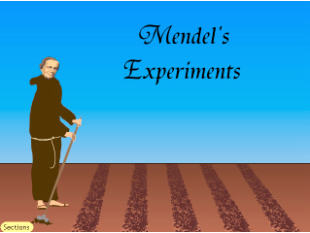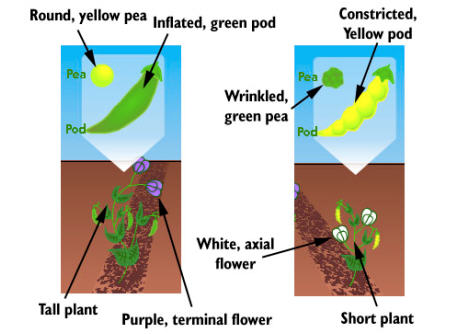Background
In this web lab, students experiment with garden pea plants (Pisum sativum) as did Austrian monk Gregor Mendel (1822-1884). Mendel chose to experiment with peas because they possessed four important qualities:
- Peas had been shown to be true-breeding (all offspring will have the same characteristic generation after generation).
- Peas exhibit a variety of contrasting traits (purple vs. white flowers; round vs. wrinkled seeds).
- The shape of the pea flower protected it from foreign pollen. Peas usually reproduce by self-pollination, in which pollen produced by a flower fertilizes eggs in the same flower.
- Pea plants grow quickly and do not require much space.
The traits that Mendel studied are listed below:
- Form of ripe seed (R) – smooth or wrinkled
- Color of seed albumen (Y) – yellow or green
- Color of flower (P) – purple or white
- Form of ripe pods (I) – inflated or constricted
- Color of unripe pods (G) – green or yellow
- Position of flowers (A) – axial or terminal
- Length of stem (T) – tall or dwarf
The Web Lab

This web lab has five sections that are accessible through the “Sections” button in the lower left-hand corner of the screen. Students can explore the entire web lab by clicking through or can jump to specific sections by using the menu. Each section is described below.
Introduction
Mendel is the guide for students throughout the web lab. When he first appears, he says, “Hello. My name is Gregor Mendel. I lived in Austria in the 1800s long before anyone knew about genes and genetics. I experimented with plants to study how traits are passed from parents to offspring ad discovered the basic rules of inheritance that are still used in your textbooks today. Come and try some of my experiments to see what you can discover about inheritance. Click Next to continue.”
The next text reads, “I used pea plants because they grow quickly and easily, and it is easy to see and recognize their different traits.”
Plant & Cross
This section of the web lab allows students to explore the traits on which Mendel experimented, then cross pea plants to see what offspring they produce.
Mendel urges students to, “Plant five pea plants and observe what they look like.” When students click the “Plant” button, the animated Mendel plants and waters five pea plants. Each of the pea plants quickly sprouts. By rolling over the plants with the cursor, the student can see the color of the pea pod, the shape of the pod, and the color and form of the ripe seed.
All of the different variations of pea plant can be seen in these growing peas, although the plants are randomly chosen each time the application is run. After they have planted and grown five plants, Mendel asks students how many distinguishing traits they see in the plants. On the next screen, he reveals that there are seven different traits:
- Pea shape (round or wrinkled)
- Pea color (green or yellow)
- Pod shape (constricted or inflated)
- Pod color (green or yellow)
- Flower color (purple or white)
- Plant size (tall or dwarf)
- Position of flowers (axial or terminal)
These traits are all pictured in the plants below:

Students are then asked to experiment with plant crosses. Using the five plants that they grew, they can cross any plant with itself or with another plant. Students may begin to notice some patterns in the ways in which traits are inherited. For example, they may recognize that a plant with white flowers crossed with itself or another plant with white flowers will produce only white flowered plants, while a purple-flowered plant crossed with itself or another purple-flowered plant sometimes produces white-flowered offspring. By encouraging students to look at individual traits during their experimentation, you may find that they begin to recognize these patterns on their own.
After they have made five crosses, the Next button is enabled and students can move on to the following section.
Predict Results
In this section of the web lab, students explore plant crosses and predict what the offspring of these crosses will look like.
A plant with round peas and a random assortment of other traits appears on the screen. Mendel says “Cross this plant with itself. What pea shapes do the offspring have?”
When the student drags the plant into one of the Parent boxes, the Cross button appears. When the student clicks the Cross button, five offspring grow. Some of the offspring from the plant with round peas have wrinkled peas. Mendel then asks, “Were you surprised that a plant with round peas produced some offspring with wrinkled peas?”
A plant with wrinkled peas appears on the screen and students are asked to cross this plant with itself. As before, when the student drags the plant into one of the Parent boxes, the Cross button appears. When the student clicks the Cross button, five offspring grow.
Mendel appears and says, “What did you learn about your peas?” Students will probably recognize that, while a plant with round peas produced some offspring with wrinkled peas, the plant with wrinkled peas produced only offspring with wrinkled peas. This is one key to Mendel’s experimentation—a trait that was not apparent in a parent generation appeared in the F1 generation.
When the student click Next, two plants appear on the screen, both with wrinkled peas. The student is asked to predict the offsprings’ pea shapes (both round and wrinkled; all round; all wrinkled; or can’t predict). Because the allele that produces wrinkled peas is recessive, the offspring of this cross will all have wrinkled peas.
Mendel then explains the concept of dominant and recessive alleles by saying, “By performing my experiments with peas, I learned a lot about genetics and how traits are passed on. I noticed that sometimes offspring seem to have traits that their parents did not show. I called the traits that appeared to mask (or hide) other traits dominant. I called traits that seemed to be hidden recessive.”
Pedigree
In this section of the web lab, students experiment with pea plants to try to discover which alleles are dominant and which are recessive. Using four different pea plants, students can cross plants with themselves or with each other to determine dominance. One strategy that students might employ is to cross plants with themselves—offspring that show a different trait than the parent of such a cross possess the recessive allele (which was hidden by the dominant allele in the parent generation).
Mendel says, “Using these plants, figure out how the trait for flower color is passed on. Which color is dominant, white or purple? This is a pedigree. You can cross plants with themselves or with each other.”
When a student clicks on one of the plant symbols (a white or a black box), the cross button appears. If the student selects two plants, then the two plants are crossed and the offspring appear below. If a student selects only one plant and clicks the Cross button, then the plant self-fertilizes and the offspring appear below. Students can cross plants as many times as they want before deciding which allele is dominant.
Explore
Students can explore all seven of the pea traits that Mendel explored in this section. Four pea plants appear in the pedigree and students can select which trait they are looking at with the pulldown menu in the upper left corner of the screen.
When students have determined which alleles are dominant, they can record their choices in their notepads by clicking on the View Notepad button. The Check button allows students to check the answers they have input into their notepads. The following table shows each of the traits and which traits are dominant and which recessive.
| Trait | Dominant Expression | Recessive Expression |
| Form of ripe seed (R) | Smooth | Wrinkled |
|
Color of seed albumen (Y)
|
Yellow | Green |
| Color of flower (P) | Purple | White |
| Form of ripe pods (I) | Inflated | Constricted |
| Color of unripe pods (G) | Green | Yellow |
| Position of flowers (A) | Axial | Terminal |
| Length of stem (T) | Tall | Dwarf |
Glossary
Axial
Flowers located near the middle of the plant.
Dominant
Traits that appear to mask (or hide) other traits.
Pedigree
A diagram of a family history used for tracing a trait through several generations.
Recessive
Traits that can be hidden in one generation and then appear in the next.
Terminal
Flowers located at the ends of the stems.
Trait
A distinguishing characteristic.
| Back to Web Lab Directory |